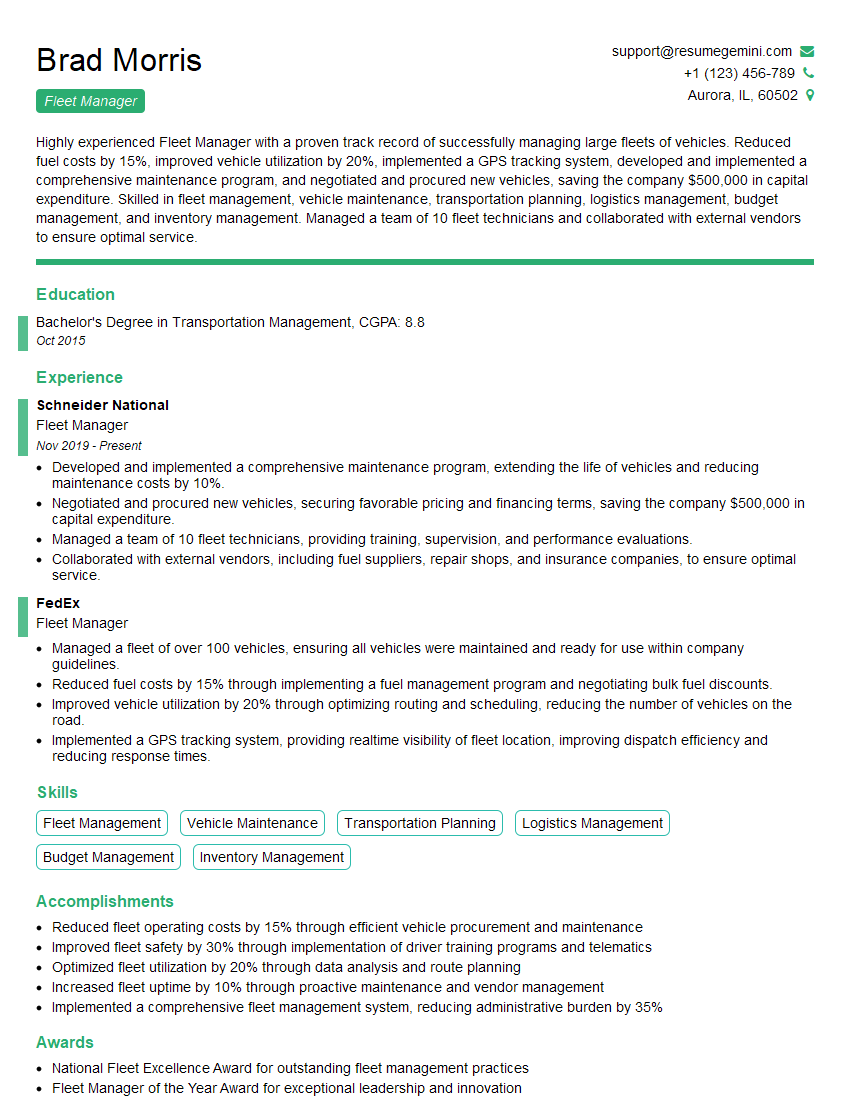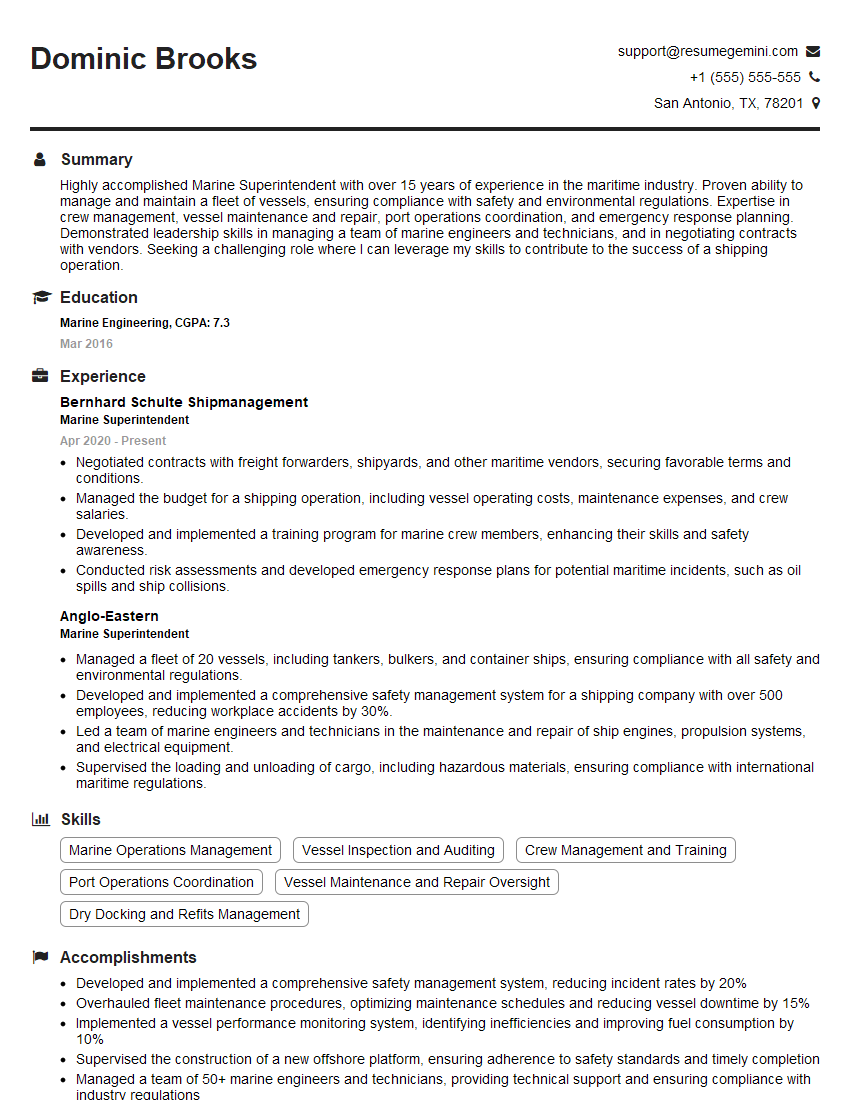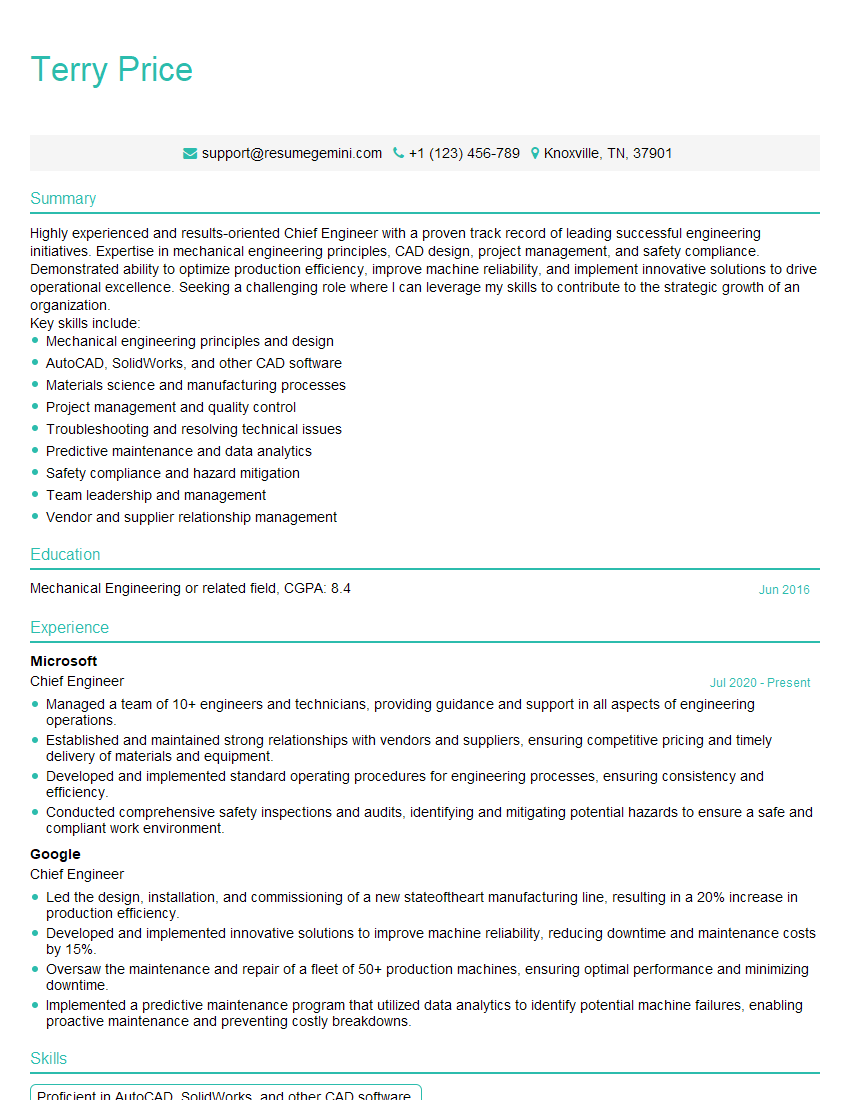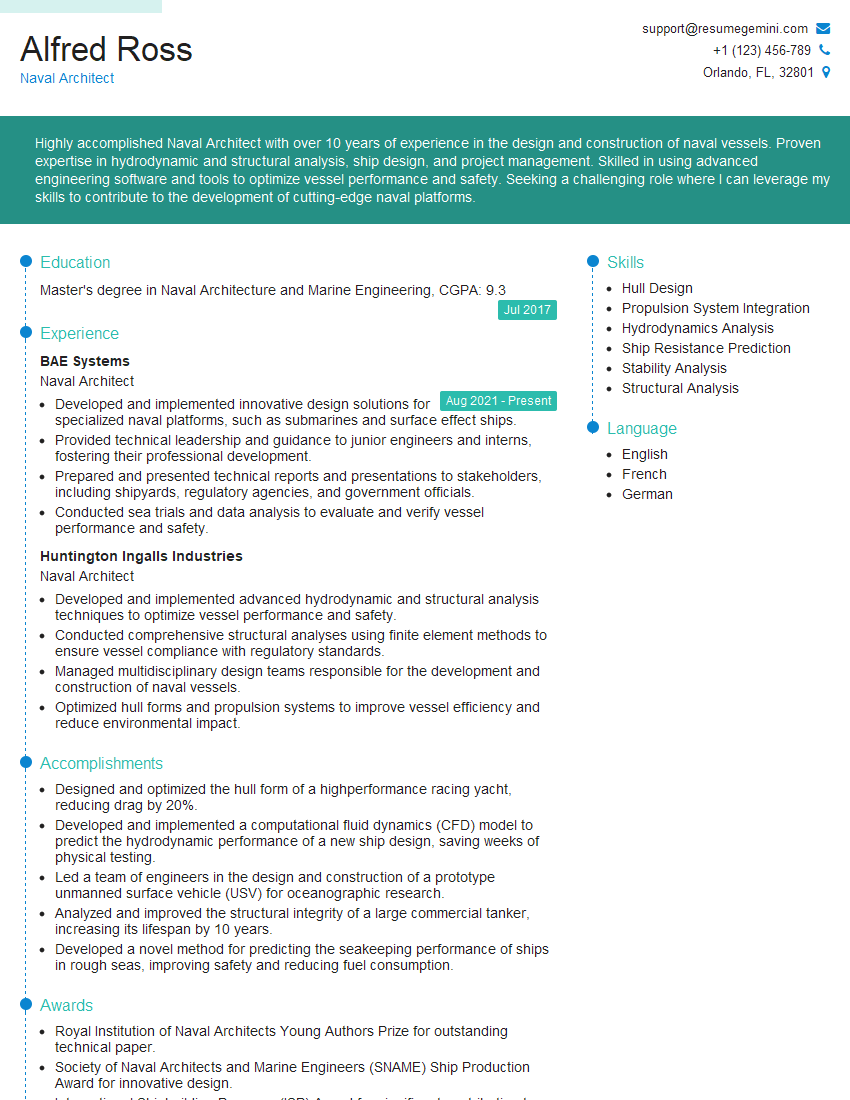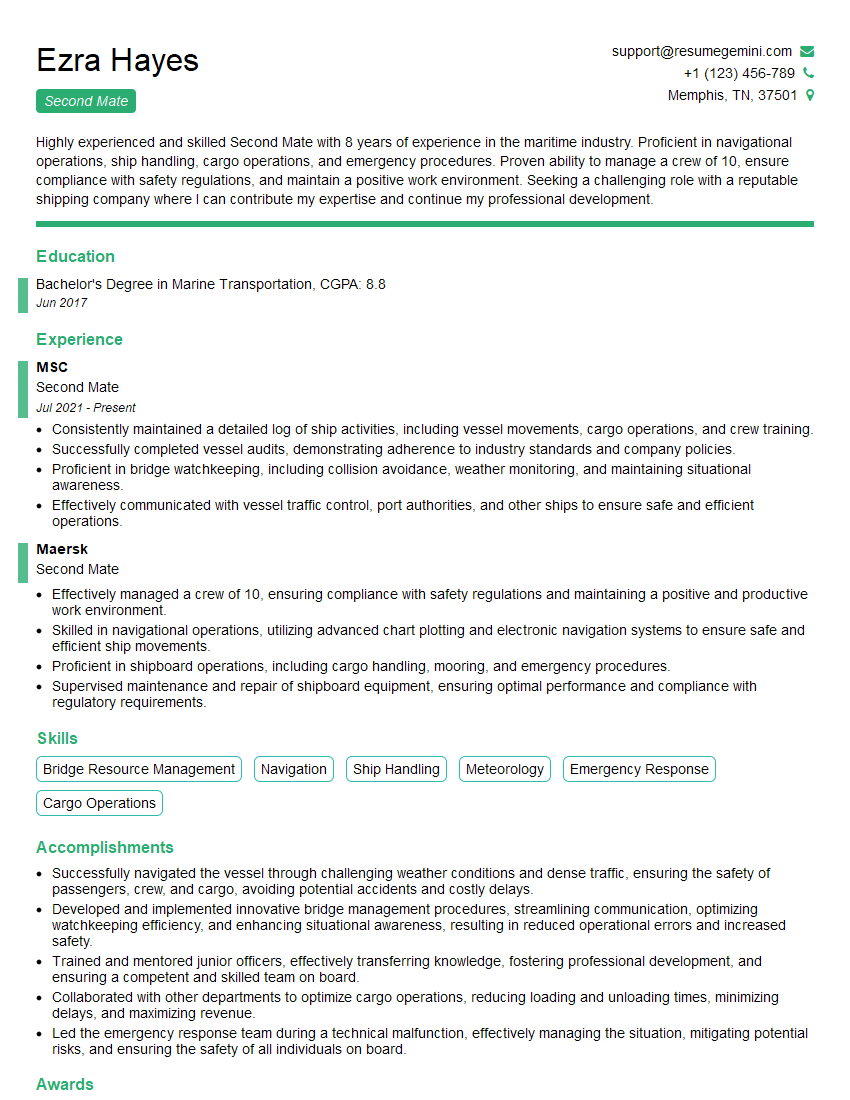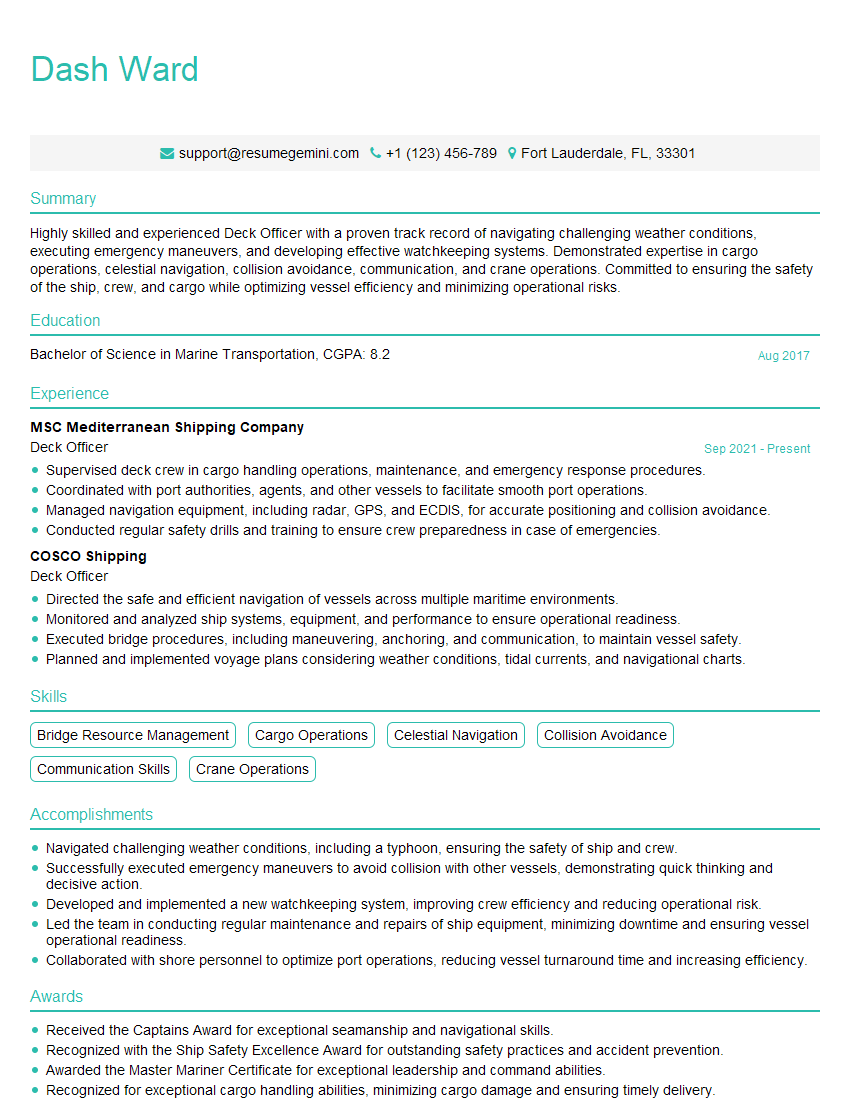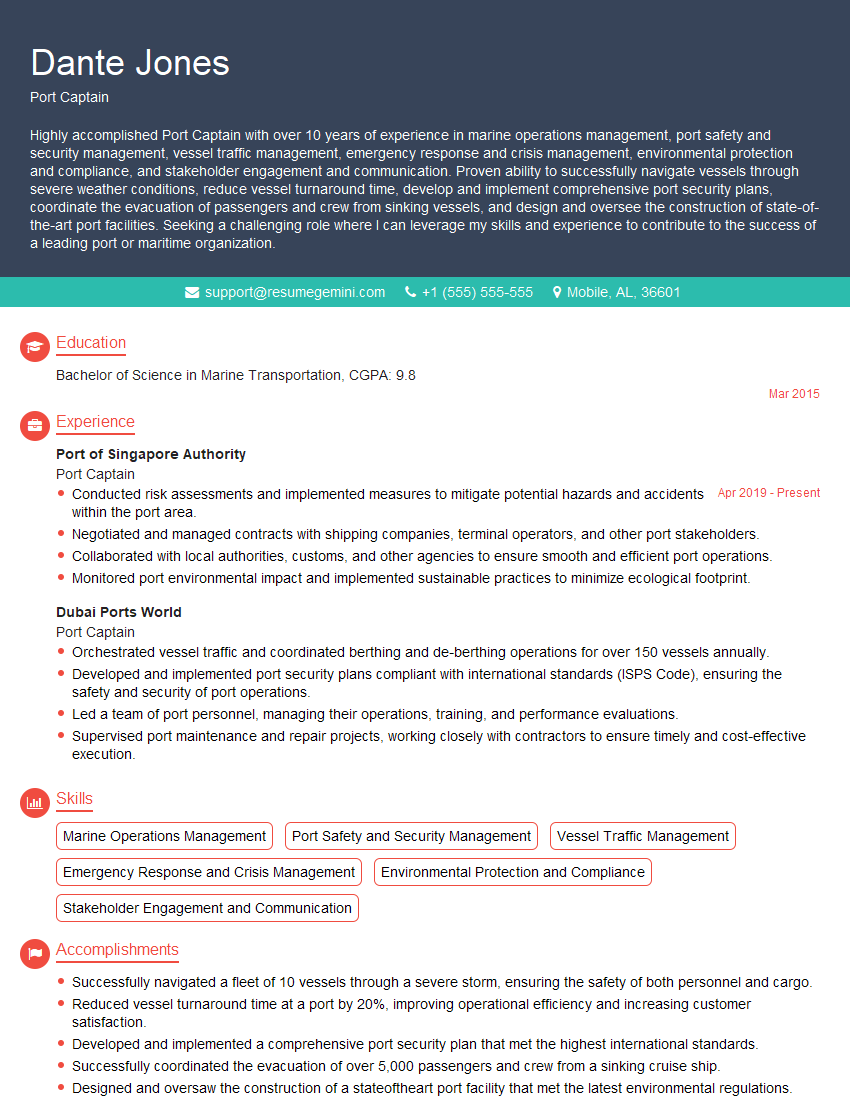Interviews are more than just a Q&A session—they’re a chance to prove your worth. This blog dives into essential Familiar with SOLAS and ISM Code Regulations interview questions and expert tips to help you align your answers with what hiring managers are looking for. Start preparing to shine!
Questions Asked in Familiar with SOLAS and ISM Code Regulations Interview
Q 1. Explain the main objectives of the SOLAS Convention.
The primary objective of the International Convention for the Safety of Life at Sea (SOLAS) is to ensure the safety of life at sea, which includes passengers, crew, and the marine environment. It achieves this through establishing minimum safety standards for ship construction, equipment, operation, and crew training. Think of it as a global safety net for the shipping industry, aiming to prevent maritime accidents and minimize their consequences. It’s a crucial international treaty, constantly updated to address evolving risks.
Q 2. What are the key chapters of SOLAS and their significance?
SOLAS is divided into several chapters, each focusing on a specific aspect of maritime safety. Some of the most significant chapters include:
- Chapter I: General Provisions: This sets the stage, outlining the scope of the convention and its application.
- Chapter II-1: Construction – Structure, Subdivision and Stability, Machinery and Electrical Installations: This covers the structural integrity, stability, and functionality of the vessel itself. It dictates rules for the design and construction to ensure safety standards are met.
- Chapter III: Life-Saving Appliances and Arrangements: This is crucial for evacuation and survival in emergencies. It specifies the types and quantities of lifeboats, life rafts, life jackets, and other safety equipment needed, as well as procedures for drills and emergency response.
- Chapter IV: Radiocommunications: This ensures vessels maintain effective communication for safety-related purposes, including distress alerts and navigation information. It mandates the use of Global Maritime Distress Safety System (GMDSS).
- Chapter V: Safety of Navigation: This covers navigational safety measures, including bridge equipment, watchkeeping procedures, and the use of navigational aids. Think of this as the ‘rules of the road’ at sea.
- Chapter VI: Carriage of Cargoes: This addresses the safe carriage of various cargo types, setting standards for loading, securing, and handling.
- Chapter XI-1: Special Measures to Enhance Maritime Safety: This chapter is particularly relevant for addressing new and evolving safety concerns. It houses the International Ship and Port Facility Security (ISPS) Code, dealing with security threats.
These chapters work together to provide a holistic approach to maritime safety, ensuring ships are safe to operate and seafarers are protected.
Q 3. Describe the ISM Code and its purpose in ship management.
The International Safety Management (ISM) Code is a mandatory international standard for the safe management and operation of ships and for pollution prevention. It’s not about individual ship safety, but about the overall safety management system of a shipping company. Imagine it as a company-wide safety manual that dictates how the company operates and manages its fleet for safety and pollution prevention. It aims to provide a framework for companies to proactively identify, assess, and mitigate risks. This ensures consistency and quality in safety management across all vessels under a company’s management. Non-compliance can lead to significant penalties.
Q 4. How does the ISM Code contribute to a ship’s safety management system?
The ISM Code directly contributes to a ship’s Safety Management System (SMS) by providing the framework for its development, implementation, and maintenance. It establishes a structured approach to identifying hazards and managing risks throughout all aspects of ship operation. It’s not just about following a checklist; it’s about building a culture of safety within the organization. The SMS developed under the ISM Code mandates the establishment of safety policies, procedures, responsibilities, and resources. It includes risk assessments, emergency response plans, audits and reviews to ensure continuous improvement. For example, a detailed risk assessment for cargo handling procedures directly influences the SMS and improves safety on board. The crew’s training and competency assessments based on the SMS ensures a safer working environment.
Q 5. What are the roles and responsibilities of the Designated Person Ashore (DPA)?
The Designated Person Ashore (DPA) is a crucial role within a company’s safety management system. They are the company’s senior representative responsible for overseeing the implementation and maintenance of the SMS. Think of them as the safety champion ashore, ensuring all ships are compliant. Their responsibilities include:
- Overseeing the SMS: Ensuring the SMS is implemented effectively and is up-to-date with relevant regulations.
- Monitoring ship operations: Regularly reviewing the performance of the SMS on each vessel.
- Ensuring compliance: Making sure the company and its ships comply with SOLAS and other relevant regulations.
- Resource allocation: Providing the necessary resources for the effective implementation of the SMS.
- Promoting safety culture: Fostering a strong safety culture within the company.
The DPA is ultimately accountable for the safety management of the company’s fleet. Their role is essential for ensuring the ongoing effectiveness of the SMS and preventing accidents.
Q 6. Explain the concept of a Safety Management System (SMS).
A Safety Management System (SMS) is a systematic approach to managing safety risks within a shipping company. It’s not just a document; it’s a dynamic process encompassing policies, procedures, practices, and resources that are designed to ensure the safety of people, the protection of the environment, and the security of ships and cargo. It’s a proactive approach, aiming to prevent accidents before they occur, rather than just reacting to incidents. A good SMS involves constant monitoring, review, and improvement, reacting to the changes in the industry.
Q 7. What are the key elements of a company’s SMS?
Key elements of a company’s SMS include:
- Safety Policy: A formal statement of the company’s commitment to safety.
- Risk Assessment: A systematic process for identifying and evaluating hazards and risks.
- Procedures and Instructions: Detailed procedures for various shipboard operations.
- Emergency Preparedness: Plans and procedures for dealing with emergencies.
- Personnel Training and Competence: Ensuring crew members are adequately trained and competent.
- Internal Audits: Regularly reviewing the effectiveness of the SMS.
- Management Review: Regular meetings to review the SMS’s performance.
- Nonconformity reporting and corrective actions: Process for identifying and correcting any shortfalls.
- Continuous Improvement: Regular updates and improvements based on experience and best practices.
These elements are interconnected and work together to create a comprehensive and effective safety management system. It’s a continuous process that needs constant review and improvement to keep pace with the dynamic nature of maritime operations.
Q 8. How are non-conformities addressed within an ISM Code framework?
The ISM Code mandates a systematic approach to addressing non-conformities – essentially, any observation or event that doesn’t align with the company’s safety management system (SMS) or relevant regulations. This isn’t simply about fixing a problem; it’s about learning from it and preventing recurrence.
The process typically involves these steps:
- Identification: Non-conformities are identified through internal audits, management reviews, accidents, incidents, or external audits.
- Recording: Each non-conformity is documented, detailing its nature, location, severity, and potential impact. A common method is using a standardized non-conformity report form.
- Investigation: A root cause analysis is conducted to understand the underlying reasons for the non-conformity. This often involves interviewing personnel, reviewing procedures, and analyzing data.
- Corrective Action: Based on the investigation, appropriate corrective actions are determined and implemented to eliminate the root cause. This might involve revising procedures, providing additional training, or replacing equipment.
- Verification: The effectiveness of the corrective actions is verified to ensure that the non-conformity is resolved and won’t reoccur. This often involves follow-up inspections or audits.
- Preventive Action: Beyond just fixing the immediate issue, preventive actions are often implemented to avoid similar non-conformities in the future. This is a crucial aspect of continuous improvement within the SMS.
For example, if an internal audit reveals a lack of proper emergency equipment maintenance logs, the corrective action might involve creating a standardized logging system, training crew on its use, and conducting a thorough inspection of all equipment. The preventive action could be regular audits of maintenance logs to prevent future lapses.
Q 9. Describe the process of conducting an internal audit according to the ISM Code.
Internal audits are a cornerstone of the ISM Code, acting as a self-assessment mechanism to ensure the SMS is functioning effectively. Think of it like a regular health checkup for your company’s safety systems.
The process typically includes:
- Planning: Defining the scope, objectives, resources, and schedule of the audit. This includes determining which areas of the SMS will be audited and who will be involved.
- Conducting the Audit: Auditors review documents, procedures, and interview personnel to verify compliance with the SMS and relevant regulations. This involves observing work processes, checking records, and confirming the implementation of safety measures.
- Reporting: Preparing a formal report that summarizes the audit findings, including any identified non-conformities. This report should clearly state the observations, their severity, and recommendations for corrective and preventive actions.
- Follow-up: Monitoring the implementation of corrective and preventive actions identified during the audit to ensure effectiveness. This might involve revisiting the audited areas to verify the implementation of recommendations.
An effective internal audit should be objective, thorough, and documented. A well-structured audit plan, using checklists and clearly defined criteria, contributes significantly to its success. The findings should be reviewed by senior management during the Management Review process.
Q 10. What are the requirements for maintaining a Ship’s Safety Management System?
Maintaining a Ship’s Safety Management System (SMS) is an ongoing commitment, not a one-time project. The requirements focus on continuous improvement and adaptation to changing circumstances. Key aspects include:
- Regular Internal Audits: As discussed earlier, regular internal audits are crucial for identifying weaknesses and non-conformities within the SMS.
- Management Review: Senior management must regularly review the SMS’s performance and effectiveness, considering audit results, accident reports, and operational data. This ensures the system remains aligned with the company’s strategic objectives.
- Documentation: The SMS must be fully documented, including policies, procedures, records, and instructions, readily accessible to all relevant personnel. Think of this as a comprehensive instruction manual for ship safety.
- Personnel Training: Crew members must be adequately trained and assessed on their roles and responsibilities within the SMS. Training programs should be updated regularly to incorporate new regulations and best practices.
- Emergency Preparedness: The SMS must include a detailed emergency preparedness plan, which should be regularly tested and updated to ensure its effectiveness in various scenarios.
- Continuous Improvement: The SMS should be regularly reviewed and improved based on lessons learned from audits, accidents, incidents, and industry best practices. Safety is a dynamic process, requiring ongoing adaptation.
Think of maintaining an SMS as similar to maintaining a vehicle – regular checks, servicing, and upgrades are necessary to ensure its continued safe and efficient operation. Neglecting maintenance leads to potential breakdowns and hazards.
Q 11. Explain the role of the Company Security Officer (CSO).
The Company Security Officer (CSO) plays a vital role in ensuring the security of a company’s vessels and related shore-based operations. They are the key point of contact for security matters and responsible for implementing and maintaining the company’s Ship Security Plan (SSP).
Key responsibilities include:
- Developing and maintaining the SSP: The CSO is responsible for creating and keeping the SSP up-to-date, ensuring it aligns with the ISPS Code requirements and the company’s operational profile.
- Training and drills: The CSO ensures that crew members receive adequate training on security procedures and participate in regular security drills.
- Security risk assessment: The CSO regularly assesses security risks and identifies vulnerabilities within the company’s operations. This involves analysing potential threats and developing mitigating strategies.
- Liaison with port authorities: The CSO acts as the main point of contact between the company and port authorities on security matters, including submitting advance notifications and cooperating with inspections.
- Incident reporting: The CSO is responsible for reporting any security incidents or breaches to relevant authorities.
Essentially, the CSO acts as the guardian of the company’s security, ensuring its vessels and operations are protected from various threats. Their role is critical in preventing and responding to security incidents.
Q 12. What is the International Ship and Port Facility Security (ISPS) Code?
The International Ship and Port Facility Security (ISPS) Code is an international maritime security standard developed by the International Maritime Organization (IMO) in response to the increased threat of terrorism. It aims to enhance the security of ships and port facilities by establishing a comprehensive framework for security risk assessment, management, and response.
The code outlines requirements for:
- Ship Security Plans (SSPs): Each ship must develop and maintain a detailed SSP outlining its security measures and procedures.
- Security assessments: Ships and port facilities must conduct regular security assessments to identify vulnerabilities and potential threats.
- Security measures: The code outlines specific security measures that ships and port facilities must implement, such as access control, surveillance, and communication protocols.
- Security personnel: The code specifies requirements for training and qualification of security personnel.
- Communication protocols: Clear communication protocols are required between ships, port facilities, and relevant authorities.
The ISPS Code establishes a layered approach to security, involving collaboration between ships, port facilities, and government agencies to ensure the safety of maritime operations. It’s a proactive measure designed to mitigate the risk of terrorist attacks and other security threats.
Q 13. How does the ISPS Code relate to the ISM Code?
While the ISM Code focuses on safety management and the ISPS Code concentrates on security management, they are both essential and interconnected. They share many similarities in their structure and implementation, promoting a culture of proactive risk management.
The key relationship lies in their integrated approach to risk management. The ISM Code provides the overall framework for safety management, while the ISPS Code provides a specialized security management framework within the broader safety system. They both involve:
- Risk assessment and management: Both codes emphasize identifying and mitigating potential risks, whether related to safety or security.
- Documented procedures: Both require detailed documented procedures and systems for managing these risks.
- Regular audits and reviews: Both rely on regular internal audits and management reviews to ensure the effectiveness of their respective systems.
- Training and competence: Both codes stress the importance of training and competence for all personnel involved.
In essence, the ISPS Code can be seen as a specialized component within the broader ISM Code framework. An effective SMS, as defined by the ISM Code, should naturally incorporate the security management aspects required by the ISPS Code.
Q 14. What is a Document of Compliance (DOC)?
The Document of Compliance (DOC) is a formal certificate issued by a flag state to a company demonstrating that its Safety Management System (SMS) complies with the International Safety Management (ISM) Code. It’s essentially a passport showing that the company meets international safety standards.
Obtaining a DOC involves a thorough audit of the company’s SMS by the flag state. The audit checks if the company’s systems, procedures, training, and documentation are compliant with the ISM Code. Once compliance is verified, the flag state issues the DOC, allowing the company to operate its vessels internationally.
The DOC is valid for a specified period, typically five years. It needs to be renewed periodically through further audits. Loss of a DOC can significantly impact a company’s ability to operate its vessels as it becomes non-compliant with international standards. The DOC signifies the company’s dedication to maintaining a robust SMS and its commitment to safety at sea.
Q 15. What is a Safety Management Certificate (SMC)?
A Safety Management Certificate (SMC) is a document issued to a ship by a flag state administration, signifying that the ship’s management system complies with the International Management Code for the Safe Operation of Ships and for Pollution Prevention (ISM Code). Think of it like a driver’s license for a ship’s safety; it demonstrates that the company managing the vessel has the processes and procedures in place to ensure safe operation and environmental protection. It’s a vital document for a ship to operate internationally, as it’s a key indicator of its safety record and operational competence.
The SMC isn’t just a piece of paper; it reflects a company’s dedication to safety. It’s evidence of thorough safety training for crew, well-defined emergency procedures, regular maintenance schedules, and a robust system for reporting and investigating accidents. The issuance of the SMC is dependent on a successful audit by a recognised organisation, who will verify all elements of the ship’s Safety Management System (SMS) against the ISM Code requirements.
Career Expert Tips:
- Ace those interviews! Prepare effectively by reviewing the Top 50 Most Common Interview Questions on ResumeGemini.
- Navigate your job search with confidence! Explore a wide range of Career Tips on ResumeGemini. Learn about common challenges and recommendations to overcome them.
- Craft the perfect resume! Master the Art of Resume Writing with ResumeGemini’s guide. Showcase your unique qualifications and achievements effectively.
- Don’t miss out on holiday savings! Build your dream resume with ResumeGemini’s ATS optimized templates.
Q 16. What are the procedures for reporting accidents or non-conformities under SOLAS and ISM?
Reporting accidents or non-conformities under SOLAS and the ISM Code is crucial for continuous improvement and preventing future incidents. Both codes mandate immediate reporting to relevant authorities and internal investigation. For example, a collision at sea would require immediate notification to the flag state, the coastal state where the incident occurred, and potentially other relevant parties, depending on the severity of the incident. The report will detail the circumstances of the event, injuries, damage, and the actions taken.
Under the ISM Code, non-conformities (deviations from established procedures) are also subject to formal reporting and corrective actions. These might range from minor equipment malfunctions to more serious procedural failures. A proper investigation should be conducted, a root cause analysis completed, and corrective actions implemented to prevent recurrence. Documentation is paramount; a well-maintained record of all incidents and non-conformities is essential for demonstrating compliance.
The procedures often involve detailed reporting forms, internal investigations, and corrective action plans. These are typically recorded in the ship’s Safety Management System documentation and may be subject to audits by the flag state or port state control.
Q 17. Explain the process of conducting a safety drill onboard a vessel.
Conducting a safety drill onboard a vessel is a critical element of maintaining a safe working environment. It’s not just about ticking boxes; it’s about ensuring that the crew is well-trained and prepared to respond effectively in various emergency situations. The process typically starts with planning. The drill should be based on realistic scenarios, such as fire, abandon ship, man overboard, or medical emergencies.
The planned drill is then announced well in advance to allow crew members to prepare. The drill itself involves detailed instructions and precise execution of the procedures, including activating alarms, deploying equipment, and following pre-determined escape routes. Following the drill, a debriefing session is critical. This allows the crew to reflect on the strengths and weaknesses of the response, identify any shortcomings in procedures or training, and suggest improvements. All aspects of the drill must be documented, providing clear evidence of participation and any lessons learned. Regular drills, covering different scenarios, are essential for maintaining a high level of preparedness and ensuring the crew’s competence and ability to react swiftly and effectively in a real-life emergency. These drills are a key element in maintaining a high level of safety onboard.
Q 18. Describe the different types of safety equipment mandated by SOLAS.
SOLAS mandates a wide range of safety equipment, categorized by function. This includes:
- Life-saving appliances: Lifeboats, life rafts, life jackets, immersion suits, and buoyant apparatus. The number and type depend on the ship’s size and the number of persons onboard.
- Fire-fighting equipment: Fire extinguishers, fire detectors, fire hoses, and fire pumps, ensuring adequate coverage throughout the vessel.
- Navigation equipment: Compasses, GPS, radar, and other equipment required for safe navigation.
- Communication equipment: VHF radios, EPIRBs (Emergency Position Indicating Radio Beacons), and GMDSS (Global Maritime Distress and Safety System) equipment for distress calls.
- Safety apparel: Protective clothing and equipment specific to the vessel’s operations.
The specific requirements for each type of equipment are detailed in SOLAS and depend on factors such as the ship’s size, type, and operational area. Regular inspections and maintenance are crucial to ensure the equipment remains operational and in good condition.
Q 19. How do you ensure compliance with SOLAS and ISM Code requirements?
Ensuring compliance with SOLAS and the ISM Code requires a multi-faceted approach, encompassing a robust Safety Management System (SMS).
- Documentation: Maintaining comprehensive documentation of all safety procedures, maintenance records, training records, and incident reports is paramount.
- Training: Regular training and drills for all crew members are crucial for ensuring they are familiar with safety procedures and know how to use the safety equipment.
- Inspections and maintenance: Regular inspections and maintenance of safety equipment and the ship’s structure are necessary to prevent equipment failure and ensure the vessel’s seaworthiness.
- Internal audits: Regular internal audits of the SMS help identify areas for improvement and ensure continuous compliance with regulations.
- Management commitment: Strong commitment from the company’s management is essential for creating a strong safety culture.
Proactive compliance—looking ahead to potential issues and proactively addressing them—is more effective than reactive compliance, which typically involves responding only after problems have arisen. Regular self-assessment and external audits contribute to overall compliance and demonstrate a company’s commitment to safety.
Q 20. What is the role of Port State Control in enforcing SOLAS and ISM Code regulations?
Port State Control (PSC) plays a vital role in enforcing SOLAS and the ISM Code by inspecting ships in port to ensure they comply with international and national regulations. Think of PSC as the ‘police’ of the maritime world, ensuring that ships do not pose safety or pollution risks. During an inspection, PSC officers may check the ship’s documentation, including its certificates (like the SMC), and verify that the ship’s safety equipment is in good working order and that the crew is properly trained.
If deficiencies are found, PSC officers can detain the ship until the deficiencies are rectified, ensuring that only seaworthy vessels are allowed to sail. This inspection process is a powerful deterrent against non-compliance and ensures a level playing field for all vessels. The findings of PSC inspections are often shared internationally, improving overall safety standards globally. The process fosters a culture of compliance, incentivizing ship owners and operators to maintain high safety standards to avoid delays and potential penalties.
Q 21. How are amendments to SOLAS and the ISM Code implemented?
Amendments to SOLAS and the ISM Code are implemented through a process involving the International Maritime Organization (IMO). The IMO, the UN agency responsible for maritime safety and security, considers proposals for amendments, often based on the analysis of incidents or technological advancements. Once approved by the IMO’s member states, the amendments become mandatory for all member states to implement within a specified timeframe.
This implementation often involves updates to national regulations and guidance, allowing for changes to reflect the new amendments. Flag state administrations then work with their shipping companies and individual ships to implement these changes into their safety systems, ensuring all operational procedures align with the latest versions of SOLAS and the ISM Code. Shipowners will need to revise their Safety Management System documentation and ensure their staff are appropriately trained. Failure to implement amendments in a timely manner can lead to non-compliance and potential penalties from PSC inspections.
Q 22. Explain the concept of ‘due diligence’ in relation to maritime safety.
Due diligence, in the context of maritime safety, refers to the continuous and proactive efforts of ship owners and operators to ensure that their vessels and operations comply with all relevant regulations and standards, such as SOLAS and the ISM Code. It’s not a one-time event but an ongoing process involving constant vigilance and improvement. Think of it as being a responsible homeowner; you wouldn’t just check your smoke alarms once and forget about them. You’d regularly maintain them and ensure your home is generally safe.
This includes maintaining the vessel in a seaworthy condition, providing adequate training to the crew, implementing effective safety management systems, and actively addressing potential hazards. Failure to exercise due diligence can lead to severe consequences, including accidents, loss of life, environmental damage, and hefty fines.
- Regular inspections and maintenance: Scheduled checks of equipment, machinery, and safety systems.
- Crew competency: Ensuring seafarers have the necessary skills, training, and qualifications.
- Safety management system (SMS): Implementing and maintaining an effective SMS compliant with the ISM Code.
- Risk assessment: Identifying and mitigating potential hazards.
Q 23. Describe your experience with conducting internal audits or inspections.
Throughout my career, I’ve extensively participated in internal audits and inspections, both as an auditor and an auditee. My experience covers various vessel types, from container ships to tankers. During these audits, I’ve meticulously reviewed documentation, conducted physical inspections of equipment and spaces, and interviewed crew members to assess their understanding of safety procedures. For example, in one internal audit on a bulk carrier, I focused on the effectiveness of their cargo securing procedures and found a minor deficiency in documentation related to the specific securing techniques used for different types of cargo. This led to immediate corrective actions and improvements to their documentation system.
I’m proficient in using checklists and audit templates aligned with SOLAS and ISM Code requirements. I’m also skilled at identifying non-conformities and recommending corrective and preventative actions (CAPAs) to address identified deficiencies. My approach is always collaborative, focusing on continuous improvement rather than simply finding fault. I ensure all findings are documented thoroughly, with clear descriptions of the deficiencies, their potential impact, and suggested solutions. The objective is to identify areas for improvement, not to find blame.
Q 24. How would you handle a situation where a non-conformity is identified?
Upon identifying a non-conformity, my immediate action is to record it accurately and objectively. This involves documenting the nature of the non-conformity, its location, severity, and potential impact. This information is essential for initiating corrective actions. For instance, if I found a fire extinguisher lacking pressure during a routine inspection, I would immediately report it. The next step is to determine the root cause and implement corrective actions to eliminate the non-conformity.
Then, I’d follow a structured approach:
- Immediate action: If the non-conformity poses an immediate risk, take immediate steps to mitigate the hazard (e.g., replacing the faulty extinguisher).
- Root cause analysis: Investigate to find the underlying reasons for the non-conformity (e.g., lack of regular inspection, faulty maintenance, damage).
- Corrective action: Implement actions to rectify the non-conformity (e.g., recharging and testing the extinguisher, implementing a more thorough inspection schedule).
- Preventative action: Implement actions to prevent similar non-conformities from occurring in the future (e.g., providing additional training on extinguisher maintenance, upgrading the inspection system).
- Verification: Ensure that the implemented actions have been effective in resolving the non-conformity and preventing recurrence.
All actions are documented and verified, with evidence retained within the company’s safety management system.
Q 25. What is your understanding of the Flag State’s role in maritime safety?
The Flag State, the country under whose flag a ship is registered, plays a crucial role in ensuring maritime safety. They are ultimately responsible for the vessel’s compliance with international and national regulations. Their responsibilities encompass many aspects, including ensuring the vessel is seaworthy, the crew is adequately trained and qualified, and the ship’s safety management system is effective. They conduct surveys and inspections to verify compliance.
This involves port state control inspections which verify compliance with the standards enforced. They also handle investigations into maritime accidents and incidents occurring on vessels flying their flag. Enforcement of regulations is key; failure to comply can result in detention of the vessel, penalties, and potential loss of the flag state’s reputation.
Essentially, the Flag State acts as the guardian of safety standards for vessels registered under its flag, ensuring they operate responsibly and in compliance with international rules, contributing significantly to global maritime safety.
Q 26. Describe a situation where you had to deal with a safety-related incident or near miss.
During my time as a safety officer on a container ship, we experienced a near miss involving a crane malfunction. While loading containers, the crane’s main hoist suddenly stopped working mid-operation. Luckily, the container was suspended safely, preventing it from falling, but the incident highlighted a significant safety risk.
Our immediate response was to secure the area and stop loading operations. We then conducted a thorough investigation, involving the chief engineer, crane operators, and other relevant personnel. We analyzed the event, reviewing maintenance logs, operator reports, and any potential contributing factors, including weather conditions. The root cause was identified as a faulty electrical component within the crane’s control system. This prompted immediate corrective action, including repair of the faulty component and a comprehensive inspection of all other cranes onboard.
Following the incident, we also reviewed our crane operation procedures, implemented additional safety checks before each operation, and provided refresher training to the crane operators. This near miss served as a valuable lesson, reinforcing the importance of preventative maintenance, thorough risk assessment, and robust safety procedures.
Q 27. How do you stay updated on changes and amendments to SOLAS and the ISM Code?
Staying updated on SOLAS and ISM Code amendments is crucial for maintaining compliance and ensuring maritime safety. I utilize several methods to achieve this:
- IMO website: I regularly consult the International Maritime Organization’s (IMO) official website for the latest circulars, amendments, and publications related to SOLAS and the ISM Code.
- Industry publications: I subscribe to reputable maritime industry journals and newsletters, which provide updates and analyses of regulatory changes.
- Professional development courses: I actively participate in training courses and seminars specifically designed to keep professionals updated on maritime regulations.
- Membership in professional organizations: My membership in relevant professional organizations provides access to updates, publications, and networking opportunities.
- Internal communication: I participate in internal meetings and training sessions to disseminate the latest regulatory updates within my organization.
By combining these strategies, I ensure my knowledge remains current and up-to-date, allowing me to effectively contribute to a safe and compliant maritime operation.
Q 28. Explain the importance of risk assessment in maritime operations.
Risk assessment is fundamental to maritime operations; it is the systematic identification, evaluation, and prioritization of hazards. This proactive process helps minimize the likelihood of accidents and incidents. A well-conducted risk assessment allows for the implementation of appropriate control measures to reduce risk to an acceptable level. Without a thorough assessment, operations run the risk of unforeseen events, causing potential harm to personnel, damage to equipment, environmental damage or even loss of life. Imagine sailing a ship without checking weather forecasts—you’re significantly increasing your risk.
The process typically involves:
- Hazard identification: Identifying all potential hazards related to the operation (e.g., equipment failure, human error, environmental factors).
- Risk evaluation: Assessing the likelihood and severity of each hazard.
- Risk control: Implementing control measures to mitigate the identified risks (e.g., preventative maintenance, safety procedures, emergency response plans).
- Monitoring and review: Regularly reviewing the effectiveness of control measures and updating the risk assessment as needed.
A robust risk assessment process is integral to compliance with SOLAS and the ISM Code, fostering a safety culture and contributing to the overall safety of maritime operations.
Key Topics to Learn for Familiar with SOLAS and ISM Code Regulations Interview
- SOLAS Convention Overview: Understand the key objectives and structure of the International Convention for the Safety of Life at Sea (SOLAS). Focus on its evolution and its impact on maritime safety.
- ISM Code Fundamentals: Master the core principles of the International Safety Management (ISM) Code, including the Safety Management System (SMS) and its implementation.
- Safety Management System (SMS) Implementation: Explore the practical aspects of developing, implementing, maintaining, and reviewing an effective SMS. Consider real-world examples and case studies.
- Documentation and Record Keeping: Understand the crucial role of documentation and record-keeping in compliance with SOLAS and the ISM Code. Know how to interpret and utilize relevant documentation.
- Emergency Preparedness and Response: Familiarize yourself with emergency procedures, drills, and response plans as outlined in SOLAS and implemented through the ISM Code. Be prepared to discuss practical scenarios.
- Audits and Inspections: Understand the audit process and how to effectively prepare for internal and external audits related to SOLAS and ISM Code compliance. Know common audit findings and corrective actions.
- Risk Assessment and Management: Learn how to identify, analyze, and mitigate risks related to ship operations. Understand the application of risk assessment within the framework of an SMS.
- Specific SOLAS Chapters: Depending on your role, delve deeper into relevant SOLAS chapters, such as those addressing cargo handling, fire safety, life-saving appliances, or radio communications.
- Company Safety and Environmental Protection (CSE) Policy: Understand the importance of a robust CSE policy in aligning company operations with SOLAS and ISM Code requirements.
- Non-conformities and Corrective Actions: Learn how to identify, investigate, and address non-conformities and implement effective corrective actions to ensure continuous improvement within the SMS.
Next Steps
Mastering SOLAS and ISM Code regulations is crucial for career advancement in the maritime industry, demonstrating your commitment to safety and compliance. A strong understanding of these regulations will significantly improve your interview performance and job prospects. To maximize your chances of success, create an ATS-friendly resume that effectively highlights your skills and experience. ResumeGemini is a trusted resource for building professional, impactful resumes tailored to your industry. We offer examples of resumes specifically crafted for candidates with expertise in SOLAS and ISM Code regulations, ensuring your application stands out from the competition.
Explore more articles
Users Rating of Our Blogs
Share Your Experience
We value your feedback! Please rate our content and share your thoughts (optional).
What Readers Say About Our Blog
Hi, I’m Jay, we have a few potential clients that are interested in your services, thought you might be a good fit. I’d love to talk about the details, when do you have time to talk?
Best,
Jay
Founder | CEO

